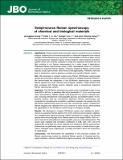| dc.contributor.author | Song, Jeonggeun | |
| dc.contributor.author | So, Peter T. C. | |
| dc.contributor.author | Yoo, Hongki | |
| dc.contributor.author | Kang, Jeon Woong | |
| dc.date.accessioned | 2024-04-29T19:52:15Z | |
| dc.date.available | 2024-04-29T19:52:15Z | |
| dc.date.issued | 2024-04-03 | |
| dc.identifier.issn | 1083-3668 | |
| dc.identifier.uri | https://hdl.handle.net/1721.1/154311 | |
| dc.description.abstract | Significance
Raman spectroscopy has been used as a powerful tool for chemical analysis, enabling the noninvasive acquisition of molecular fingerprints from various samples. Raman spectroscopy has proven to be valuable in numerous fields, including pharmaceutical, materials science, and biomedicine. Active research and development efforts are currently underway to bring this analytical instrument into the field, enabling in situ Raman measurements for a wider range of applications. Dispersive Raman spectroscopy using a fixed, narrowband source is a common method for acquiring Raman spectra. However, dispersive Raman spectroscopy requires a bulky spectrometer, which limits its field applicability. Therefore, there has been a tremendous need to develop a portable and sensitive Raman system.
Aim
We developed a compact swept-source Raman (SS-Raman) spectroscopy system and proposed a signal processing method to mitigate hardware limitations. We demonstrated the capabilities of the SS-Raman spectroscopy by acquiring Raman spectra from both chemical and biological samples. These spectra were then compared with Raman spectra obtained using a conventional dispersive Raman spectroscopy system.
Approach
The SS-Raman spectroscopy system used a wavelength-swept source laser (822 to 842 nm), a bandpass filter with a bandwidth of 1.5 nm, and a low-noise silicon photoreceiver. Raman spectra were acquired from various chemical samples, including phenylalanine, hydroxyapatite, glucose, and acetaminophen. A comparative analysis with the conventional dispersive Raman spectroscopy was conducted by calculating the correlation coefficients between the spectra from the SS-Raman spectroscopy and those from the conventional system. Furthermore, Raman mapping was obtained from cross-sections of swine tissue, demonstrating the applicability of the SS-Raman spectroscopy in biological samples.
Results
We developed a compact SS-Raman system and validated its performance by acquiring Raman spectra from both chemical and biological materials. Our straightforward signal processing method enhanced the quality of the Raman spectra without incurring high costs. Raman spectra in the range of 900 to
1200cm −1 were observed for phenylalanine, hydroxyapatite, glucose, and acetaminophen. The results were validated with correlation coefficients of 0.88, 0.84, 0.87, and 0.73, respectively, compared with those obtained from dispersive Raman spectroscopy. Furthermore, we performed scans across the cross-section of swine tissue to generate a biological tissue mapping plot, providing information about the composition of swine tissue.
Conclusions
We demonstrate the capabilities of the proposed compact SS-Raman spectroscopy system by obtaining Raman spectra of chemical and biological materials, utilizing straightforward signal processing. We anticipate that the SS-Raman spectroscopy will be utilized in various fields, including biomedical and chemical applications. | en_US |
| dc.language.iso | en | |
| dc.publisher | SPIE-Intl Soc Optical Eng | en_US |
| dc.relation.isversionof | 10.1117/1.jbo.29.s2.s22703 | en_US |
| dc.rights | Creative Commons Attribution | en_US |
| dc.rights.uri | https://creativecommons.org/licenses/by/4.0/ | en_US |
| dc.source | SPIE-Intl Soc Optical Eng | en_US |
| dc.title | Swept-source Raman spectroscopy of chemical and biological materials | en_US |
| dc.type | Article | en_US |
| dc.identifier.citation | Jeonggeun Song, Peter T. C. So, Hongki Yoo, and Jeon Woong Kang "Swept-source Raman spectroscopy of chemical and biological materials," Journal of Biomedical Optics 29(S2), S22703 (3 April 2024). | en_US |
| dc.contributor.department | Massachusetts Institute of Technology. Laser Biomedical Research Center | |
| dc.contributor.department | Massachusetts Institute of Technology. Spectroscopy Laboratory | |
| dc.relation.journal | Journal of Biomedical Optics | en_US |
| dc.eprint.version | Author's final manuscript | en_US |
| dc.type.uri | http://purl.org/eprint/type/JournalArticle | en_US |
| eprint.status | http://purl.org/eprint/status/PeerReviewed | en_US |
| dc.date.updated | 2024-04-29T19:39:18Z | |
| dspace.orderedauthors | Song, J; So, PTC; Yoo, H; Kang, JW | en_US |
| dspace.date.submission | 2024-04-29T19:39:20Z | |
| mit.journal.volume | 29 | en_US |
| mit.journal.issue | S2 | en_US |
| mit.license | PUBLISHER_CC | |
| mit.metadata.status | Authority Work and Publication Information Needed | en_US |
